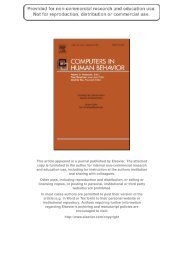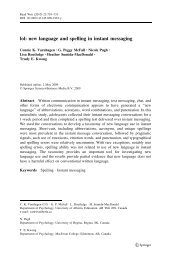Six Models for the Internet + Politics
Create successful ePaper yourself
Turn your PDF publications into a flip-book with our unique Google optimized e-Paper software.
44 <strong>Six</strong> <strong>Models</strong> <strong>for</strong> <strong>the</strong> <strong>Internet</strong> + <strong>Politics</strong><br />
tionary <strong>the</strong>ory of change in favor of streng<strong>the</strong>ning <strong>the</strong> hand of already constituted<br />
political actors and amplifying more familiar political <strong>for</strong>ces of organized<br />
accountability advocacy.<br />
Kiirti 24 (meaning “report” or “reputation” in Sanskrit) is a conflict resolution<br />
plat<strong>for</strong>m deployed in India that is built upon Ushahidi software. Kiirti launched<br />
in Beta in Spring 2010 and is offered <strong>for</strong> free to participating NGO’s during its<br />
initial trial stage. Kiirti offers web-based, SMS, as well as phone plat<strong>for</strong>ms <strong>for</strong><br />
users. The conceptual framework behind Kiirti, is that Ushahidi software can be<br />
used <strong>for</strong> citizens to mass aggregate everyday political problems ranging from<br />
environmental concerns to concerns of targeted communities such as those with<br />
retina disease in India. The Kiirti model is to work directly with <strong>the</strong> specific<br />
NGO, such as <strong>the</strong> Coalition Against Corruption, to custom build a unique<br />
website through <strong>the</strong> Kiirti interface where users can lodge complaints, which<br />
will be received by <strong>the</strong> NGOs on <strong>the</strong> back end of <strong>the</strong> ICT plat<strong>for</strong>m. Kiirti makes<br />
<strong>the</strong> web site customizable <strong>for</strong> each NGO based on <strong>the</strong> specific features. For<br />
instance, in <strong>the</strong> case of Retina India, Kiirti has set up a unique phone line <strong>for</strong><br />
users. Through involving citizenry in this way, Kiirti is promoting both direct<br />
citizen engagement and awareness, which evolves Ushahidi beyond electoral<br />
initiatives.<br />
Looking at <strong>the</strong> users of all of <strong>the</strong>se ICT plat<strong>for</strong>ms, it is mainly professional<br />
users in <strong>the</strong> <strong>for</strong>m of, NGOs, private companies, as well as journalists who use <strong>the</strong><br />
user-generated in<strong>for</strong>mation. Thus, suggesting that mass in<strong>for</strong>mation will continue<br />
to be used not by <strong>the</strong> proverbial “everybody” but ra<strong>the</strong>r a select few to<br />
whom <strong>the</strong> in<strong>for</strong>mation is most directly applicable toward. The average citizen<br />
may create <strong>the</strong> in<strong>for</strong>mation, but <strong>the</strong> way this in<strong>for</strong>mation gets related to <strong>the</strong> government<br />
follows <strong>the</strong> traditional mechanisms of institutional power. There<strong>for</strong>e,<br />
<strong>the</strong>se ICT plat<strong>for</strong>ms are not trans<strong>for</strong>ming <strong>the</strong> relationship of <strong>the</strong> citizens with<br />
<strong>the</strong>ir government. Ra<strong>the</strong>r Ushahidi and Uchaguzi are enabling professional users<br />
to work as liaisons between citizens and <strong>the</strong>ir government.<br />
Conclusion<br />
In <strong>the</strong> pages above, we offer six different models that depict alternative conceptions<br />
of <strong>the</strong> place and effect of ICTs in politics. These models are by no<br />
means exclusive or fully comprehensive. In fact, some of <strong>the</strong>m even complement<br />
each o<strong>the</strong>r. For instance, Model 6 (Social Monitoring) can be viewed as<br />
a limited species of Model 2 (“Here Comes Everybody”), and Model 4<br />
(Truth-Based Advocacy) can be seen as a more mature and professionalized<br />
version of Model 1 (Muscular Public Sphere). Taking a bird’s eye view, <strong>the</strong>se<br />
models aim to reflect <strong>the</strong> interaction between digital technologies and politics<br />
from <strong>the</strong> perspectives of both technologists and of political analysts at <strong>the</strong><br />
same time. Technologists stress <strong>the</strong> novel capabilities—such as dramatically<br />
lower communication and search costs, many-to-many communication, and<br />
<strong>the</strong> dynamics of crowdsourcing and collaborative production—that <strong>the</strong>se new<br />
technologies make possible. Political analysts, on <strong>the</strong> o<strong>the</strong>r hand, are especially<br />
attentive to <strong>the</strong> importance of incentives as drivers of human action<br />
and <strong>the</strong> role of organizations and institutions in producing outcomes such as<br />
laws and public actions. Each of <strong>the</strong>se models takes both kinds of considerations<br />
into account.<br />
The result of <strong>the</strong> above analysis is that <strong>the</strong> most heady and revolutionary<br />
expectations <strong>for</strong> <strong>the</strong> trans<strong>for</strong>mative role of digital technology—an egalitarian<br />
and empowered public sphere, <strong>the</strong> displacement of traditional organizations by<br />
<strong>Internet</strong>-facilitated self-help through self-organization, and direct digital democ-<br />
24 http://www.kiirti.org/.
















